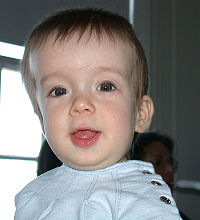
Photo from wikipedia
Abstract Traditional fronto-orbital advancement continues to be a useful operation for correction of craniosynostosis involving the coronal or metopic sutures. Recently, distraction osteogenesis has been used to correct a variety… Click to show full abstract
Abstract Traditional fronto-orbital advancement continues to be a useful operation for correction of craniosynostosis involving the coronal or metopic sutures. Recently, distraction osteogenesis has been used to correct a variety of cranial deformities. Studies have mostly focused on posterior vault distraction due to its simplicity and greater volume gain when compared with anterior vault distraction. However, certain patients are not candidates for posterior distraction due to anterior deformity and need for expansion of the frontal skull. The authors have developed a technique that allows for both reshaping as well as distraction of the anterior cranial vault. This was a retrospective chart review performed between March 2012 and October 2016 at a single institution by a single plastic surgeon. Thirty-nine (39) patients were included in this study. The indications for surgical intervention were signs of increased intracranial pressure or severe anterior skull deformity in the setting of craniosynostosis. The authors reviewed patient characteristics, length of follow-up, number of previous and subsequent surgeries, complications, and rate of relapse. The average age of patients undergoing the procedure was 5.2 years (range 6 months–15 years). Twenty-four (24) patients had 1 previous surgery, 3 had 2 previous surgeries, 1 had 3 previous surgeries, and 11 had no previous surgeries. The average follow-up was 2.5 years (range 6 months–4 years). One patient had a broken activation wire requiring return to the operating room. Three (3) patients (2 Apert and 1 Crouzon) underwent subsequent posterior vault distraction surgery. All patients demonstrated significant improvement in forehead cosmesis. Anterior cranial vault reconstruction with distraction is a safe alternative to traditional cranial vault reconstruction. It can improve forehead shape and position in older children who have had previous surgery as well as patients with severe anterior skull deformity associated with craniosynostosis.
Journal Title: Journal of Craniofacial Surgery
Year Published: 2019
Link to full text (if available)
Share on Social Media: Sign Up to like & get
recommendations!